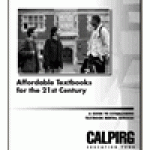
Affordable Textbooks for the 21st Century:
A Guide to Establishing Textbook Rental Services and Other Alternative Business Models
College textbooks have always constituted a meaningful portion of higher education costs. In the past two decades, however, the price of textbooks has soared to unprecedented levels.
Downloads
CALPIRG Education Fund

Executive Summary
College textbooks have always constituted a meaningful portion of higher education costs. In the past two decades, however, the price of textbooks has soared to unprecedented levels. Textbook prices are increasing at more than four times the inflation rate for all finished goods, according to the Bureau of Labor Statistics Producer Price Index.
Recent research conducted by the State PIRGs reveals that publishers are inflating the price of textbooks by adding CD-ROMs and other supplements to current texts and forcing cheaper used books off the market by producing expensive new editions of textbooks that differ only marginally from the previous edition. In its report “Ripoff 101,” the California Student Public Interest Research Group (CALPIRG) found that most faculty do not consider many of these add-ons useful and support efforts to streamline textbook costs and extend the shelf life of current textbook editions.
One innovative way to lower students’ textbook costs is allowing students to rent, rather than purchase, their textbooks each semester. According to the National Association of College Stores (NACS), approximately 20 colleges already rent textbooks, many of which have rented textbooks for more than a century.
Students attending colleges and universities that rent textbooks spend less on textbooks than students who purchase their books. Students using existing textbook rental services pay $130 to $240 per year plus some course materials; students attending public four-year colleges currently pay an average of $800 to $900 to purchase their textbooks each year. A recent survey by CALPIRG found that students at California universities spent an average of $898 on textbooks in the 2004-2005 school year. Similarly, the College Board found students at four year public institutions spent an average of $853 for textbooks and supplies that same year. Taking supplies and course materials into consideration, a student renting her textbooks could save at least $400 every year, or a total of $1,600- $2,000, depending on the length of her college career.
With tuition and textbooks costs on the rise, universities need to explore ways to help maintain access to higher education by lowering students’ costs. Textbook rental services provide a valuable and economical alternative to the high cost of purchasing textbooks.
This document is a twelve step guide for colleges and universities interested in lowering textbook costs for students by transitioning to a textbook rental service or exploring new, innovative business models. This guide is designed to help schools develop a viable model that will best fit each individual campus, based on lessons drawn from existing rental services.
Twelve Steps to Renting Textbooks
1. Create a Textbook Rental Service Advisory Committee
2. Establish Textbook Rental Mission
3. Establish Operating Guidelines
4. Update Contracts
5. Establish Faculty Textbook Adoption Guidelines
6. Determine Rental Fees and Startup Costs
7. Determine Storage Requirements
8. Purchase and Build Textbook Inventory
9. Develop Computer Tracking System / Communication with Campus
10. Determine Store Layout and Staffing
11. Teach Students and Faculty How to Use Textbook Rental Service
12. Continue to Explore New Solutions to the High Cost of Textbooks
For those readers interested in transitioning to a rental system, the Appendix provides a list of resources, including contacts and materials currently used to operate existing rental services.
The California Public Interest Research Group Education Fund (CALPIRG) is a result-oriented public interest group that protects consumers, encourages a fair sustainable economy, and fosters responsive democratic governance.
Topics
Find Out More


5 steps you can take to protect your privacy now

Fixed for the Holidays

